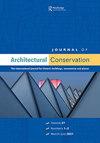Seismic strengthening criteria and techniques in the Regno di Napoli during the eighteenth century
IF 1
3区 艺术学
0 ARCHITECTURE
引用次数: 2
Abstract
ABSTRACT The Borbone Regno di Napoli, including Southern Italy, was struck by several earthquakes during the eighteenth century, some of high magnitude. The Borbone technicians tried to counterpose seismic measures aimed at reducing the vulnerability of the constructions under threat from earthquakes. Neither the seventeenth century nor the first years of the eighteenth century emphasized a significant seismic engineering development. In general, the reconstruction activity did not highlight, in the analysed historical chronicles, any technical device concerned with buildings’ seismic retrofittings. However, some constructions, executed or strengthened after the 1732 quake that hit Naples, presented timber elements embedded in the masonry, with the main intention of bonding the orthogonal panels of the building and counteracting the wall collapsing. The earthquakes sequence that struck the Calabria region in 1783 marked a resolved trend inversion characterized by interventions, as well as strengthening interventions, aimed at improving building responses during an earthquake. The Borbone government, showing a deep and advanced knowledge about the seismic engineering principles, imposed a code for earthquake-resistant constructions that regulated, beside new buildings execution, repair interventions for damaged buildings.18世纪那不勒斯雷格诺地震加固标准和技术
18世纪,包括意大利南部在内的那不勒斯地区发生了几次地震,其中一些震级很高。Borbone的技术人员试图采取抗震措施,以减少建筑物在地震威胁下的脆弱性。无论是17世纪还是18世纪的头几年,都没有强调地震工程的重大发展。总的来说,在分析的历史编年史中,重建活动并没有突出任何与建筑物抗震改造有关的技术设备。然而,一些在1732年那不勒斯地震后建造或加固的建筑,在砖石中嵌入了木材元素,主要目的是将建筑的正交面板粘合在一起,抵消墙壁的倒塌。1783年袭击卡拉布里亚地区的地震序列标志着一个已解决的趋势反转,其特征是干预,以及加强干预,旨在改善地震期间的建筑反应。博尔本政府对地震工程原理有着深刻而先进的了解,他们制定了抗震建筑规范,除了新建筑的施工外,还规定了受损建筑的修复措施。
本文章由计算机程序翻译,如有差异,请以英文原文为准。
求助全文
约1分钟内获得全文
求助全文

 求助内容:
求助内容: 应助结果提醒方式:
应助结果提醒方式:


